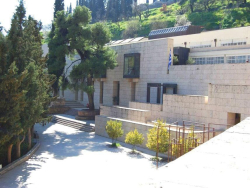Archaeological Museum of Delphi

Archaeological Museum of Delphi
The museum was established in 1903 with money donated by the great national benefactor Andreas Syngros, designed by the French architect Tournaire and originally consisted of 2 wings. Between 1935 and 1936, an extension of the building was created, while in 1956 a warehouse was added.
In 1958, based on the design of the architect Patroklos Karantinos, the museum acquired 2 new halls, while at the same time the 3 existing rooms were re-formed. In 1999, the institution was last renovated by the Hellenic Ministry of Culture with Alexandros Tombazis as the architect in charge. In its current form, it is housed in a 2-story structure, has a total area of 2,270 m² and consists of 14 rooms full of archaeological finds of great historical importance. It further has 558 m² of storage space, a ceramic and metal maintenance workshop, and a mosaic restoration studio. There is also a canteen and a pamphlet shop in the museum.
The exhibition focuses on the history of the Delphi Museum and includes objects that cover all periods from prehistoric to late antiquity. The exhibits are divided into sections so that visitors can view and understand them better.
Sections of the Museum
The beginning of the sanctuary and the first votive offerings (Rooms 1-2)
Exhibits Mycenaean figurines, bronze tripods, figurines of men's figures, jewelry, while in a distinctive position is exhibited the small bronze kouros.
Early Archaic Times (Room 3)
The statue of the twin kouros (Cleon and Vitis) makes an impression.
The room with the ivory (Room 4)
These are items made of precious materials (gold, silver, copper, ivory). A special spot is occupied by the Apollonian Trinity and the silver bull.
The Treasure of Sifnos (Room 5)
Architectural elements (friezes, gable, Caryatids), as well as the Sphinx of Naxos, are presented.
The Temple of Apollo (Room 6)
Architectural elements of the temple are presented.
The treasure of the Athenians (Rooms 7 - 8)
The sculptural decoration of the treasure of the Athenians who had dedicated to Delphi is exhibited.
5th Century votive offerings (Room 9)
Samples from the decoration of the 2 treasures of the temple of Athena are presented.
The dome (Room 10)
Dedicated to the circular building of the temple of Athena (Dome).
Post-classical - Hellenistic Era (Room 11)
Offers to the god by Daochos.
Late Hellenistic - Roman Period (Room 11)
Impressive votive offerings to the god of Emilios Pavlos (frieze).
Inioxos (Room 13)
It is a masterpiece statue of the Hellenistic Period with inserted eyes and inserted eyelashes.
The end of the Sanctuary (Room 14)
Showing portraits and inscriptions from the time of the Roman emperors.









